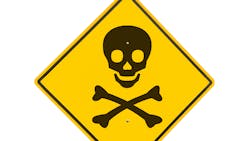Proper disposal of waste solvents is usually considered more of an environmental issue than a safety issue. However, it is often both.
Some environmental issue mistakes:
- Pouring it out into a floor drain. The idea is it will just evaporate, but that is not what happens. The solvent ends up in the wastewater system, where it can damage pipe and fittings until it makes its way to the waste treatment plant. There, it can cause significant damage to the system before making its way to a natural body of water.
- Pouring it into a waste oil drum. Waste oil and solvents are treated very differently. If an EPA inspection finds solvent in a drum labeled waste oil, the fines can be significant. If even a little solvent is accidentally put into a waste oil drum, the whole drum must be classified as waste solvent.
- Pouring it into the regular trash or the dumpster out back. This practice gets it into the landfill, where it can cause a failure in the liner and then make its way into the groundwater.
Some safety issue mistakes:
- Setting a can of it out to evaporate. When this is done, it’s usually done with a small working can, so it’s insignificant, right? Check the Safety Data Sheets for the solvent. If it says to wear a respirator or to ventilate, that means the solvent attacks human tissue.
- Removing PPE before the solvent is disposed of. Gloves and respirators should stay on until the task is completed.
- Closing the lid securely and storing it in a corner of the shop for future use. This sounds smart, but there is a reason why there are special lockers for flammables. If this solvent is flammable, there is only one place you should store it.
- Using a paper funnel to filter it, pour it back into the supply can of the solvent. Now you have a paper filter soaked in solvent and the supply can is contaminated with nearly everything that contaminated the waste solvent. The paper funnel is insufficient for cleaning used solvent.
A few things to keep in mind
- Solvent is dispensed in one direction only. It never goes back into whatever container you took it out of.
- Solvent is considered waste solvent, whether you use it or not, once it’s transferred from its main storage container to a use-for-the-job container.
- To avoid excessive spills and general waste, estimate how much solvent you will need to perform the intended task and take only that much. It is better to accidentally kick over a half cup of solvent than a half-gallon of it.
So, how do you safely dispose of waste solvent? If your company has a policy/procedure for this, become familiar with it (or refamiliarize yourself) before obtaining the solvent. If there is no procedure, you’ll have to take ownership of the deficiency by writing your own. It’s a good idea to run that past your supervisor in case you missed anything. It should include these elements:
- The specific waste collection container to pour the waste solvent into. If this cannot be identified, then a special container will need to be obtained and clearly labeled before using the solvent.
- Fire hazard issues associated with the use and disposal of this solvent, along with the specific means of fire prevention or suppression you will have available during use and disposal.
- PPE and ventilation required for solvent disposal method.
- What do to with container(s) that held the waste solvent.
- Where and how to report the existence of waste solvent so it can be removed from site in compliance with EPA regulations.
About the Author

Mark Lamendola
Mark is an expert in maintenance management, having racked up an impressive track record during his time working in the field. He also has extensive knowledge of, and practical expertise with, the National Electrical Code (NEC). Through his consulting business, he provides articles and training materials on electrical topics, specializing in making difficult subjects easy to understand and focusing on the practical aspects of electrical work.
Prior to starting his own business, Mark served as the Technical Editor on EC&M for six years, worked three years in nuclear maintenance, six years as a contract project engineer/project manager, three years as a systems engineer, and three years in plant maintenance management.
Mark earned an AAS degree from Rock Valley College, a BSEET from Columbia Pacific University, and an MBA from Lake Erie College. He’s also completed several related certifications over the years and even was formerly licensed as a Master Electrician. He is a Senior Member of the IEEE and past Chairman of the Kansas City Chapters of both the IEEE and the IEEE Computer Society. Mark also served as the program director for, a board member of, and webmaster of, the Midwest Chapter of the 7x24 Exchange. He has also held memberships with the following organizations: NETA, NFPA, International Association of Webmasters, and Institute of Certified Professional Managers.
